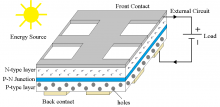If you would like to see more information on this case study, click here!
You can request this case study and a WCDE staff member will get back to you.
 Dr. Aicheng Chen is an Associate Professor at Lakehead University, Thunder Bay, Ontario, conducting research in Electrochemistry, Bioelectrochemistry, Green Chemistry, Materials Science and Nanotechnology. Dr. Chen and his research team have been exploring the preparation methods and properties of nanostructures for green chemistry applications for many years. An example of these nanostructures is tin dioxide (SnO2) dye-sensitized solar cells (DSSCs). These cells are a cheaper alternative to more traditional solar cells which use silicon (Si) or titanium dioxide (TiO2) to harvest solar energy. For economically feasible research, it is desirable to know the cheapest method of preparing SnO2 cells.
Dr. Aicheng Chen is an Associate Professor at Lakehead University, Thunder Bay, Ontario, conducting research in Electrochemistry, Bioelectrochemistry, Green Chemistry, Materials Science and Nanotechnology. Dr. Chen and his research team have been exploring the preparation methods and properties of nanostructures for green chemistry applications for many years. An example of these nanostructures is tin dioxide (SnO2) dye-sensitized solar cells (DSSCs). These cells are a cheaper alternative to more traditional solar cells which use silicon (Si) or titanium dioxide (TiO2) to harvest solar energy. For economically feasible research, it is desirable to know the cheapest method of preparing SnO2 cells.
Sean O’Neill, a University of Waterloo co-op student, was asked by Dr. Chen to investigate three different methods of SnO2 film preparation and recommend the best method. The methods to be reviewed were chemical vapour deposition, the solution based method and electrochemical deposition.
This case study illustrates an example of cost and benefits analysis and can be used in Special Topics ME course (ME597). It also introduces students to the various factors that comes in to play while evaluating the feasibility of current or new microfabrication technologies. Finally, the case enables students to make decisions based on qualitative and quantitative cost and benefit analysis
If you would like to see more information on this case study, click here!
You can request this case study and a WCDE staff member will get back to you.
Contact Waterloo Cases in Design Engineering
Steve Lambert
Tel: (519) 888-4728
Email: steve@uwaterloo.ca
The University of Waterloo acknowledges that much of our work takes place on the traditional territory of the Neutral, Anishinaabeg and Haudenosaunee peoples. Our main campus is situated on the Haldimand Tract, the land granted to the Six Nations that includes six miles on each side of the Grand River. Our active work toward reconciliation takes place across our campuses through research, learning, teaching, and community building, and is co-ordinated within the Office of Indigenous Relations.